Welcome to BAOYUE PEARL, we supply all shapes freshwater pearl with wholesale price, contact us to get a free Quote:

South Sea Pearl Grading - Insider's Guide
This detailed visual guide is a fantastic reference article for learning about White and Golden South Sea pearls and the A-AAAA Grading Scale that NaturalPearlSource.com uses.
Featuring visual aids and a systematic breakdown of what exactly you can expect to observe in each grade, this guide will be like having your very own jewelers’ grading hank!
Feel free to read the whole article, or use the links featured in the Table of Contents to skip ahead directly to parts that concern you.
Use these links to navigate this article:
What Makes South Sea Pearls Beautiful?
Luster, Luster, LUSTER! And natural pearl colors found nowhere else on Earth.
White and Golden South Sea pearls are known to have the thickest nacre layers of all cultured saltwater pearl types, averaging between 2.0-4.0mm thick, or more.
Almost universally described by pearlers as “satiny” in look, the South Sea pearl’s luster is softer in appearance than that of the Japanese Akoya Pearls.
South Sea pearls radiate a gorgeous “glow” that appears to emanate from within, rather than the harder “mirror-like shine” that Akoya pearls are famous for.
That’s not to say that South Sea pearls can’t feature very bright, very sharp luster – they can and do. Check out this picture that showcases a pair of Golden South Sea Drops with almost Metallic levels of luster (WOW).

The Science Behind Pearl Color and Luster
Like every other cultured pearl variety out there, the visual phenomenon of Body Color, Overtone and Luster are due to the compaction and smoothness of the pearl's crystalline nacre layers.
White and Golden South Sea pearls are both nucleated using a perfectly round mother-of-pearl bead nucleus.
The nucleus is surgically placed into the gonad of the oyster, along with a tiny, 1.0mm square piece of donor mantle tissue from a different oyster. The incision is covered over and the oyster is placed into an “after surgery” tank for a few days while it heals from the procedure.

After a short time, the bead nucleus stimulates the formation of a pearl sac, which envelopes the nucleus in a loose “purse” and the oyster begins secreting nacre.
This continues on for about 2-3 years, as the oyster continuously covers the interior bead nucleus with thousands of concentric layers of nacre and conchiolin, forming a pearl.

Some definitions you should know are:
♠ Nacre is the sum total accumulation of aragonite and conchiolin.
♠ Aragonite is composed of hexagonal-shaped, semi-transparent crystal platelets made of crystalline calcium (CaCo3). These platelets are extremely tiny - measured in the microns!
♠ Conchiolin is the semi-transparent to darker organic “glue” that is layered in between the aragonite platelets. I imagine that conchiolin is like the cement interspersed between bricks, holding a wall together.
♠ White South Sea pearl conchiolin is usually colorless to light grey and pale beige, which allows the pearl to present that “bright white” appearance that is so well-loved.
♠ Golden South Sea pearlconchiolin is present in a range of darker pigments like orange, brown and reddish-brown. This contributes to the pearl’s famous Golden color (depending on a variety of other existing factors).
The tighter and more compact the aragonite and conchiolin layers are, the more intense the luster, color and orient you will perceive on the pearl’s surface.
Now that you’re a bit more familiar with how and why these various elements combine to create the visual phenomenon of "Wow!!" to us humans, we can move onto learning about the A-AAAA South Sea Pearl Grading Scale that Pure uses.
The breakdown below examines each pearl grade, and lays out specific benchmarks that South Sea pearls must meet in order to "make the grade".
South Sea A-AAAA and Gem Quality Pearl Grading Breakdowns
The images depicted in these grading breakdowns include a mix of perfect round and off-round/button and baroque South Sea pearl necklaces.
Keep in mind that baroque or drop-shaped pearls are graded using the same A-AAAA scale as perfectly round pearls.
In addition to luster, color and surface quality, for baroque and semi-baroque pearls, the symmetry of shapes and shape-matching play very important roles in determining the pearls' overall quality.

♠ Finest South Sea pearl grade available – Very Rare.
♠ Luster is extremely sharp, with crisp, distinguished reflected light sources.
♠ No blemishing or inclusions may be seen with the naked eye.
♠ Perfectly spherical and/or symmetrical pearl shapes.
♠ Nacre measures between 2.0-4.0mm thick or more.
♠ Pearl Earrings set perfectly clean.
♠ Pearl Necklace will be very clean upon close inspection (6-Inches or less). Zero deep inclusions allowable.
♠ Excellent matching; little to no variation in color, tone, luster, shape or size.

♠ Nacre measures between 2.0-4.0mm thick.
♠ Luster is sharp with Excellent rate of reflection.
♠ Reflected light sources have mostly crisp edges; satining or blurring may be observed with careful inspection.
♠ Excellent light return.
♠ Blemish rate less than 5-10% on each pearl surface.
♠ Earrings will set clean in front.
♠ Strands will be mostly clean to the eye upon inspection. Only very small inclusions allowable.
♠ Near-perfect matching; little to no variation in color, tone, luster, shape or size.
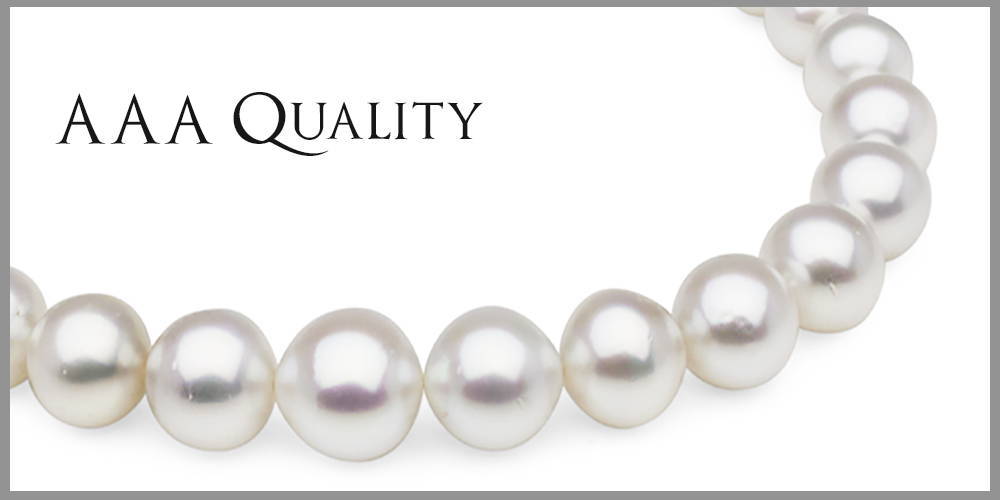
♠ Nacre measures between 2.0-4.0mm thick.
♠ Luster is mostly sharp with Very Good rate of reflection.
♠ Facial features can be observed in pearl surfaces, overall face shape easily visible.
♠ Reflected light sources have slightly blurred, some slightly satiny edges.
♠ Very High light return.
♠ Blemish rate less than 10-15% on each pearl surface.
♠ Up to two deep blemishes allowable on 18-inch strand.
♠ Very good matching; little variation in color, tone, luster, shape or size.

♠ Nacre measures between 2.0-4.0mm thick.
♠ Luster is Good to Soft, reflected objects are blurred.
♠ Facial features are typically not observed in pearl surfaces.
♠ Reflected light sources have blurred edges.
♠ Good rate of light return.
♠ Blemish rate less than 30% on each pearl surface.
♠ Two to four heavy/deep blemishes allowable on 18-inch strand.
♠ Good matching; some variation in color, tone, luster, shape or size.

♠ Luster is Fair to Soft with low rate of reflection.
♠ Reflected light sources are blurry.
♠ Facial features cannot be observed in pearl surfaces.
♠ Blemish rate less than 40% on each pearl surface.
♠ Some heavy blemishes may be observed throughout layout, however deep inclusions should not make up more than 10-15% of the total layout.
♠ Fair to good matching; some variation in color, tone, luster, shape or size.
With Golden South Sea pearl grading, color also plays an important role.
The best rule of thumb to go by is: the deeper the golden color, the rarer and more valuable the pearls are, all other quality factors being equal.
** Cultured White and Golden South Sea pearls are one of the few “organic gemstones” in the world (the others being amber, jet and coral). That means they are the end result of a biological process. Tiny imperfections in even “Gem” Quality pearls are expected.
Per the FTC: § 23.26 Misuse of the words "flawless," "perfect," etc. (a) It is unfair or deceptive to use the word "flawless" as a quality description of any gemstone that discloses blemishes, inclusions, or clarity faults of any sort when examined under a corrected magnifier at 10-power, with adequate illumination, by a person skilled in gemstone grading.
Cultured pearls will never be as flawlessly perfect as a synthetic glass or plastic bead can be – nor should you want them to be.
Mother Nature always signs her creations, and these unique inclusions and marks can act as a built-in ID system that marks the pearls as yours and yours alone.
Pure’s AAA Quality Only Policy for South Sea Pearls
Pure does not offer any AA+ Quality Round loose or matched South Sea pearl pairs; all Round pearl earrings, pearl pendants and pearl rings featured on Pure are AAA Quality only.
We use this Quality Control policy to make sure that each pendant, pair of earrings, or pearl ring that leaves our office will set clean in front and the sides of the pearl, so you’re only showing off Pure gorgeousness, and NOT blemishes.

As with all precious gemstones, and especially when it comes to online bargain shopping it pays to remember: price isn’t everything.
Pure’s “AAA Quality Only” policy may make our prices look to be a bit less competitive at the outset, I believe that adhering to this high quality standard results in prettier pearl jewelry and happier, more loyal customers in the long run.
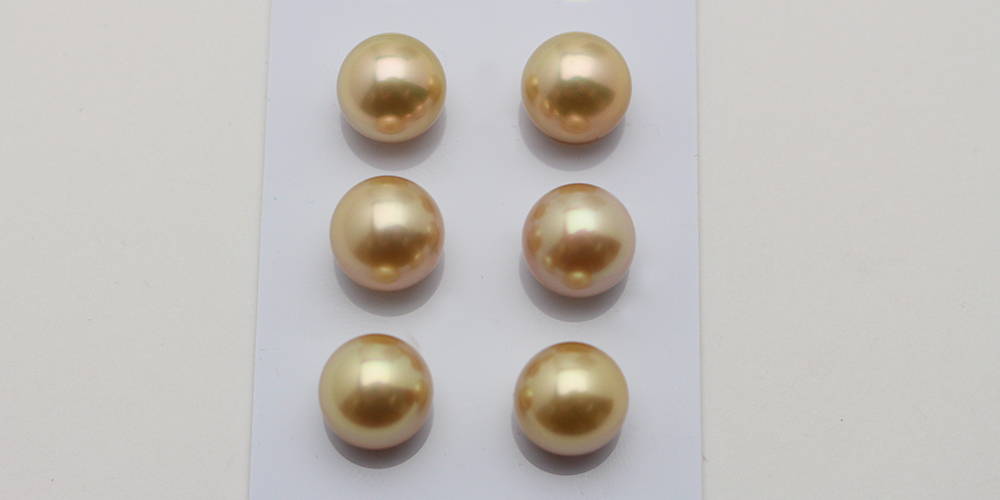
AAA vs AAAA Quality South Sea Pearl Necklaces
A full 18-inch strand allows us some more room to play with pearl necklace layouts, so we can offer a bigger variety of price points – we want all of our customers to be able to afford the "Queen of Pearls". Pure offers an array of South Sea pearl necklaces that span the entire range from A-AAAA Quality that will suit almost any budget.
In my personal, professional opinion, I almost always recommend selecting a smaller-sized but higher quality strand of South Sea pearls over larger, less lustrous pearls … or to not get too hung up on "Perfect Round" pearl shapes
Remember that Luster - and Orient whenever visible - makes or breaks these little guys as gemstones, so aim to up that “L” factor whenever possible.


That said, there’s no denying the WOW Factor that a really large layout of White or Golden South Sea pearls exudes. The Off-Round / Button-Shape South Sea pearl necklace pictured just above crossed my desk in 2016 and was gone within a few weeks (because look at that Orient!!)
Snagging a screaming deal like this depends on whether off-round and button-shaped pearls, or a few inclusions is a huge turn off for you, or if the luster and orient that is plain to see here overwhelms those other factors.
If you’d like to learn more about the 7 Value Factors for cultured pearls click here.
What is Intermediate South Sea Pearl Grading?
With Pure’s South Sea necklace collection, you’ll often see necklaces with grades that will look like "AA/AAA Quality" and/or "AAA/AAAA Quality" in their descriptions. These “intermediate” grades are given to pearl strands when the pearls almost-but-not-quite make it to a whole letter grade like AAA Quality.
Generally, what these intermediary grades mean is that the pearl’s surface quality (i.e. amount of inclusions) or shape is graded at a lower level like AA, but the pearl’s luster and shine pushes the layout to that higher grade.
It could also be the reverse in that the pearls’ surfaces are extremely clean, but the luster isn’t quite there. However, I usually grade strands like that with a lower grade anyways because what makes pearls beautiful as a gemstone?
That's right: Luster!
Let’s see how this plays out with real South Sea necklaces …
Ridges are an inclusion that is unique to Freshwater pearls, quite likely due to their solid-nacre composition.
Ridges are totally covered in nacre, so they’ll be whatever color the pearl is, i.e. white for white, pink for pink and so on.
Score marks or scoring begins with a small pin prick or pit, and then appears to be drawn off lightly over the surface of the pearl … they can look like small comets or shooting stars for those of us with a romantic viewpoint.
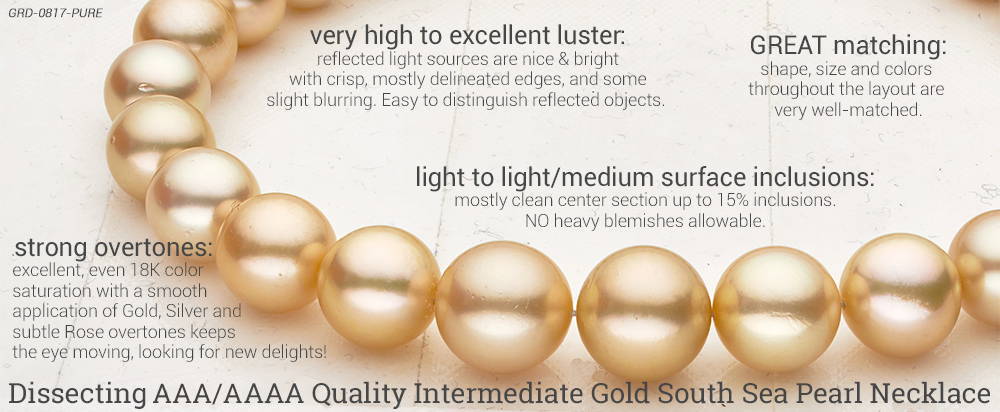
Check out the photo above showing a section of GRD-0817-PURE, an 18K Medium-Deep Golden South Sea Round Pearl Necklace which was given an intermediate AAA/AAAA Grade. Notice in particular:
Bright, touchable Luster: The high rate of light reflection from the pearl’s surfaces really brightens up the pearls, and gives these gorgeous gems a visual sense of epth, and helps the pearls appear to glow for the observer. The Luster could be sharper and more defined around the edges of reflected light sources, so AAA Quality.
Nicely saturated colors: The strand featured is an 18K Medium-Deep Golden hue with pale Silver, Gold and subtle Rose overtones. If the primary body color were deeper, say a 22K Golden hue, it would push the pearls into AAAA Grade territory.
Well matched pearls: The pearls are incredibly well matched for shape, size, luster, surface quality and overall tone. AAAA Quality level.
Very light surface inclusions. I count 5 very tiny blemishes in this center section, and the rest of the layout is really Very Clean. AAAA Quality, easily!
So based on our pearl grading value factors we have:
Luster: AAA Quality.
Surface Quality: AAAA Quality, hands down.
Color: AAA Quality – pretty, but pastel.
Matching: AAAA Quality easily - the pearls are excellently matched for round shape, smooth and subtle graduation of size, luster, surface quality and overall tone.
Overall Grade: AAA/AAAA Quality Golden South Sea Pearl Necklace, leaning HARD to a true AAAA Grade.
Common South Sea Pearl Inclusions

Inclusions are a fancy-sounding jewelry term for surface blemishes and natural growth characteristics that interrupt the smoothness of the pearl’s surfaces.
In this section, I’ll break down what is and is not an inclusion (it’s not always what you think!): how these growth characteristics effect the pearl, and how they can affect value.
South Sea pearl inclusions and growth characteristics are an easy way to:
A: Ensure that the pearls are the genuine article, and not man-made fakes like shell pearls. Created synthetic pearls are usually perfect, with identical pearl beads through a layout, and feature no marks, spots, bumps, ridges, scoring or bulleting.
B: Are a built-in ID system that you can use to identify that set of pearls as yours and yours alone. Get to know your pearl's unique markings, and you’ll never get fooled by a pearl swap!
MOST White and Golden South Sea pearl blemishes are the color of the corresponding nacre (so, gold or white in color), so often these surface blemishes don’t stand out glaringly unless they’re very deep or there are a lot of them bunched together.
The pictures below are all of White and Golden South Sea pearl strands that are raw, unretouched photos (so no “glamourizing” has been done here).
Keep in mind that these are close-ups of inclusions on pearls for educational purposes … in other words, don’t get scared by the focusing on the spots!

Mottling/Bulleting/Plating of the Surface – “Mottling” also known as “Bulleting” and sometimes “Plating” is a subtle texture on the surface of the pearl that (to me, at least) often looks like a tiny hammer has been used to repetitively mark the pearl.
This is a growth characteristic, and NOT an inclusion – it’s actually indicative of very thick nacre layering. Mottling is created in the same nacre color as the rest of the outer surface of the pearl, and so usually can only be noticed upon up-close inspection. Bulleting does not count against a pearl’s surface grade.

Pin Pricks – Ranging in size from a tiny needle points to small pricks that look like the pearl has been poked with a pencil, pin pricks are probably the most common pearl inclusion visible today.
Pin pricks can be grouped together in small clusters, or stand on their own individually, which is preferable.

Pits – These formations are pin pricks taken to extremes, and resemble large indentations, craters or even holes in the nacre.
Pits count as heavy or deep blemishes when grading a strand of pearls, and their best case scenario is that they are at least the color of the pearl, and totally covered by nacre.
Worst case scenario is they are very deep and display the organic conchiolin layer; jagged, sharp edges may eventually lead to chipping.
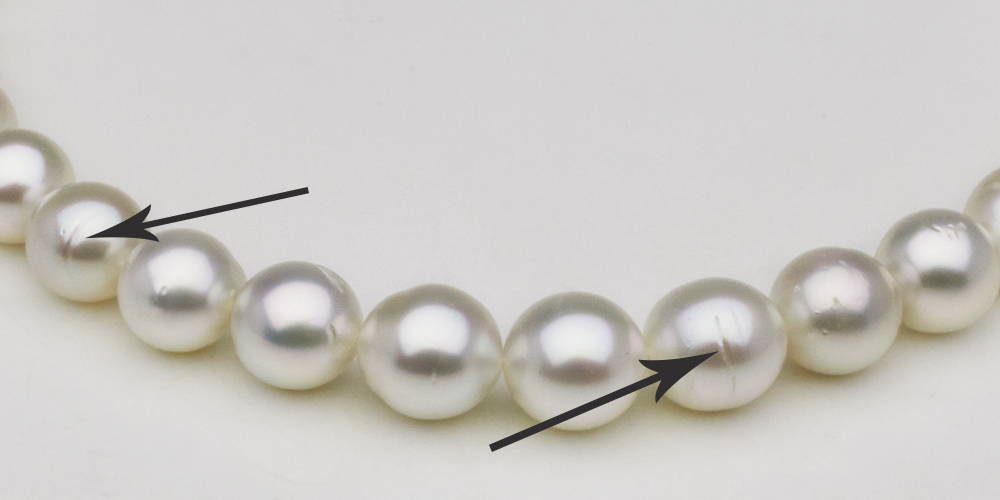
Score Marks / Grooves - Scoring and/or groove inclusions are the second most common South Sea pearl inclusion.
They resemble tiny streaks to moderately-sized channels that look “carved” in the surface nacre (often they remind me of little shooting stars or comets trailing their way across the pearl when they’re very thin and light).
The shallower, the better when it comes to scoring marks, and these should also be totally covered in nacre, with smooth, unbroken edges.

Knobs and Tips – Maybe one of the most interesting looking growth characteristic of all.
Both tips and knobs form on the ends of the pearl (99% of the time on baroque shaped pearls). Occasionally, knobs can have additional features that resemble small bubbles. They can be rounded or elongated, pointy protrusions located at either end of a pearl.
Knobs and tips are natural growth characteristics and are also not counted as inclusions or blemishes.
Keep an eye out for chipping or cracking however, as these vulnerable areas may affect the pearls’ long-term durability.

Circles / Circling – Originally marketed for black Tahitian pearls under the “Circles of Love” campaign in the 1980’s, “circles” or “circlés” are also a natural growth characteristic that does not count negatively towards the surface grade of the pearl.
These are single or heavily concentrated rings running around the pearl’s entire circumference, and imbue the pearls with an incredibly unique appeal.
Again, circles are not pearl blemishes, but, blemishes can form inside them (usually in the form of tiny pin pricks or grooves).

Uneven Nacre Accumulation –Smooth, concentric and even layers of nacre producing a totally unblemished, shiny pearl surface is ideal.
However, nacre building within an oyster responds to a variety of factors: environmental, temperature fluctuations, parasites, etc., can all interrupt this process to some degree or another.
When the layering process is disturbed, a build-up of crystalline material can occur, resulting in bumps, ridges and uneven surfaces.
How to Buy a South Sea Pearl Necklace ?

Finding the perfect strand of White or Golden South Sea pearls for anyone is a balancing act of beauty over budget.
MOST South Sea pearl inclusions are small and isolated, and their color generally will match that of the surrounding surface nacre, meaning that they’ll blend with the surface and will be only noticeable upon up-close inspection of 6 to 12-Inches. This is especially true if the pearl’s overtones and luster are at high levels, masking marks and distracting the eye.
Also, remember that the A-AAAA South Sea grading benchmarks count blemishes for each pearl, as well as the entire strand overall – so the 90% or 80% blemish-free totals only count for a relatively small area of blemishes, and there remains plenty of room for pearls that are clean and lovely on even a lower quality necklace.
When viewed through the eyes of one who loves their pearls, pearl inclusions can become an integral facet of the pearl’s unique character.
Like a snowflake, or the infamous “jardins” or “gardens” (which is the French name for inclusions in Emeralds), a pearl’s markings declare each gem as a totally unique and individual creation of Mother Nature.
Can't get enough of our South Sea pearls? For a deep dive on these stunning gems, visit our Ultimate Buyer's Guide for South Sea Pearls
Ready to Learn More about Pearl Grading?
View the rest of our pearl grading guides:

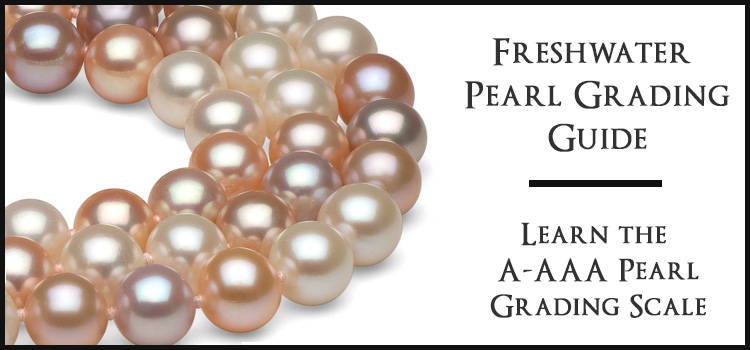



 WhatsApp Code
WhatsApp Code